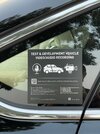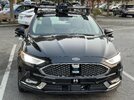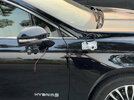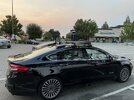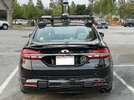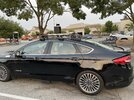Let's not count the eggs before they hatch, especially when talking about volume releases. I'm getting deja vu on the Audi's promise of release of L3 in 2017/2018. 3-4 years later the only L3 we see is still only a 100 vehicle lease only fleet from Honda.
As for Mobileye, there's already a discussion above about the lead times from demo to volume consumer release.
For Huawei, my confidence in the claims of that company went down like a rock given their deception on HarmonyOS/HongmengOS (this article in particular being very revealing):
Huawei’s HarmonyOS: “Fake it till you make it” meets OS development
I was one of the first ones who called out Audi and BMW years ago when it was clear they were just in it for the PR. I even made a thread about it.
Audi Pilot Driving actually had a good system but management gobbled it up like they did the 4 other development project that came after Piloted Drive was shut down.
Most people think i'm biased, but i'm not. I have ripped into just about every traditional automaker out there.
UPDATE: A few updates are on in order. Looks like Mobileye is no longer joint with BMW on driving policy although they have given BMW the blueprints to move forward. This change most likely came from the new Mercedes/BMW autonomous deal in FEB 2019. Not only that, as a result of this Amnon no...

teslamotorsclub.com
About the Huawei Phone OS, they were forced to make a phone in acouple months without Google Android so they forked the Android Open Source Platform (which alot of companies do) and rebranded it with plans to improve and differentiate as time goes. This is actually what makes them a tech company. An automaker wouldn't do that. They would take 5 years and then come out with absolutely nothing. Tesla did the same thing by ultilizing GoogleNet. Anyway this is different and meanless to the discussion. There is no good open source SDC software to fork.
Depends on what you define for "right". which is the crux of the argument (and why as I mentioned trying to pick "winners" in a comparison chart doesn't work given people have different criteria).
If "right" is releasing L5, then none of the players are "right" given none of them have reached L5 (or even just wide release L4). The basic paths being taken I see is:
1) Tesla's approach: work to release end-to-end L2, then improve reliability of that until it is to L4 then eventually L5 level. The idea is that they can convert their fleet at a flip of a switch as soon as the software is ready.
2) Others: release L4 in geofenced area relying heavily on HD maps, and achieve L5 by mapping the entire world or at least specific countries. Note that many companies don't have a explicit goal to achieve L5, they would be perfectly happy with L4 (robotaxies can operate just fine in geo fences), in which case the goal would instead be wide release L4 (releasing L4 in many more places than just experimental fleets, like Uber/Lyft's current coverage area vs when they originally started a decade ago).
I'm talking about Elon claiming level 5 in two years for the past 6 years and others either claiming Level 5 is impossible or that it will take a long long time, some mentioning 2030+.
But Elon kept claiming he will do it in 2018.
Propilot is probably the biggest disappointment. I remember all the hype about it being L4 (from your post in 2017 "
Complete autonomous driving for all driving situation on the highway.") and then the final release isn't even L3 and it hasn't even reached US shores yet as of now. From what I can find, it was released in a limited manner in Japan in late 2019 for some Skylines. That's the biggest problem with all of Mobileye's solutions, it takes forever to reach the consumer.
Four Upcoming Self Driving Level 3 Cars by 2019
That system is based on EyeQ4, and from a quick google, Mobileye had engineering samples already back in 2015 (they may have demoed an early release earlier than that even, given you follow Mobileye closely, perhaps you know):
Moving Closer to Automated Driving, Mobileye Unveils EyeQ4® System-on-Chip with its First Design Win for 2018
And here 6 years later we are still waiting for it to hit US shores in volume. Does that mean we won't see any significant release of the things demoed by Mobileye recently until 2027? A lot can change by then.
Neither nissan nor me ever promoted the propilot 2.0 as L4, but always as L3 in every related marketing. Even then the system as it is was never released. I'm not even talking about whether its L2 or L3. I mean the original system had 4 lidars, 12 surround cameras. The release hardware had 0 lidars and 3 forward cameras.
It definitely was disappointing. But its par for course for traditional automakers. I made this post over 2 years ago and its still accurate. There's a reason there's still no automaker with a reliable OTA update system after years on years. Yet startups perfect it from day one.
Note that mercedes actually ended up giving up and going completely Nvidia for both hardware, software, ADAS and AV.
VW is still stuck creating teams, fumbling the development, nuking everything and creating another team. Rinse and repeat.
UPDATE: A few updates are on in order. Looks like Mobileye is no longer joint with BMW on driving policy although they have given BMW the blueprints to move forward. This change most likely came from the new Mercedes/BMW autonomous deal in FEB 2019. Not only that, as a result of this Amnon no...

teslamotorsclub.com
Its not even just because of safety risk. they absolutely have no ambition. You can hand them a L5 self driving system today free and they will find a way to fumble the roll out and spend 3 years just deciding what to do with it. Then spend another 3 three rolling out 100 cars in a city. safe to say they are hopeless.
Its not the engineers its the 80 years old business suit heads calling the shots.
The only hope are start-ups. These two articles are good reads...
The reason for the long deployment time is due to the trad automakers. Mobileye already came out and said it takes traditional automakers and tier 1s 3-4 to integrate. EyeQ4 went to production in Q4 2017 and it took NIO till the first half of 2018 to integrate and deploy it. So less than a year. Yet it takes someone like Ford and GM 4 & 3 years respectively to deploy EyeQ4 and Ford with crap driving policy. For EyeQ5, Geely's new Zeekr brand is integrating and deploying less than 1 year after its production date.
So blame the traditional automakers. However the eventually released propilot 2.0 in Japan is coming to the US this year.
Anyway, If you want the latest and greatest Mobileye system, you will only find it on EV startup cars not traditional automakers.
I mean you will literally see the latest and greatest supervision on the Zeekr this year.




